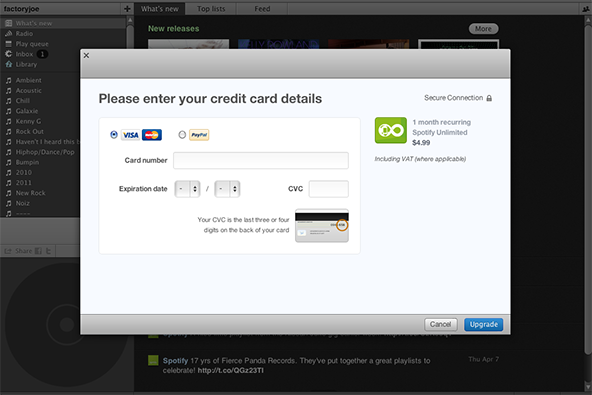What Is the Best Way to Take Credit Cards on Your Website?

Ever since Square first enabled everyone with a smart phone to take credit cards for payment almost three years ago, we have been deluged by an endless string of similar offerings coming from all over the place — everyone from the smallest of start-ups to the largest of traditional payments companies wanted a piece of the action. It’s been a ferocious struggle for dominance of a sizable brand new niche of the payments market, as I was recently reminded when Groupon announced the latest upgrade of its own Square clone. Not only is the daily deal site offering payment processing rates that are lower than Square’s by close to one percent, but it charges new customers no processing fees at all on the first $5,000 in credit card transactions! That made me recall a British start-up, which some time ago offered “a simple flat fee of ?ú4.99 (?é¼6.50 or $7.99) a month for unlimited use with 0% transaction fees” (unsurprisingly, this offer is no longer on the table, although the start-up seems to still be alive).
But Groupon’s latest update also reminded me of the fact that the Square-led revolution has largely bypassed the e-commerce end of the merchant spectrum. Yes, there are a few well-publicized self-proclaimed “new-age” online payment service providers, like Stripe in the U.S. and Paymill in Europe, but they have been unable to make much headway beyond taking huge sums of venture capital cash. So why have online businesses been ignoring the Stripes of the online payments world? More importantly, is that the right decision for your own business? Well, I believe that the answer to the former question is that, on close inspection, the newcomers look very much like the traditional processors they aim to displace, only more expensive. So yes, ignoring them is the right decision. But what exactly should you be looking for in a payment processor? Let’s go over the basics.
A Closed-Loop System vs. an Open One
Before we go to the pricing, which I know is what interests you the most, we have to go over the type of processing system you need to select for your website and you have two principal options. On the one hand, Stripe and Paymill, as well as some of the “old-age” processors, have bundled the software part together with the merchant account one into a single product. By contrast, most of the traditional processors are keeping the two separate. What difference does that make to you? Well, if you signed up with Stripe, but for some reason were not satisfied with their service and decided to switch to another processor, you would have to go through the software integration all over again. On the other hand, if you had kept the two components of your payment processing service separate, you might be able to use the same software package — called a payment gateway — to connect to a processor of your choice.
For example, the most popular payment gateway — Authorize.Net — is set as the default connectivity option by most payment processors, UniBul included. So, if you had an Authorize.Net-based set-up with a given processor, but weren’t satisfied and decided to leave, you would be able to integrate with another processor’s system by simply going to your gateway account’s control panel and replacing three sets of numbers. Compare that to having to go through a full-blown integration. And, by the way, everyone would be telling you that their website integration method is the simplest and the most painless one ever developed. However, if you do take this part of the process for granted, you are almost certainly setting yourself up for trouble, especially if you are using some other software system for your website that would need to be integrated with your merchant account. So always ask specific questions about integration, before selecting a service provider.
What Type of Pricing Should You Choose?
Similarly to Square and its clones, Stripe and Paymill use flat-rate pricing models — meaning that they charge you the same processing rate for all credit and debit card transactions. In the case of Stripe, that rate is 2.9 percent plus $0.30; the corresponding numbers for Paymill are 2.9 percent plus ?é¼0.28. Almost no traditional payment processor uses flat pricing of this kind. And neither should you accept it.
The biggest selling point of the flat-rate pricing model is that it is simple — you know exactly what you will pay in fees on every card transaction you process. But here is a question for you: would you prefer a pricing plan that is simple or one that saves you money? If you chose the latter, you should go with an interchange-plus pricing structure. Interchange what? Well, interchange is the fee your processor — new-age, old age or whatever — pays to the issuer of every card it has accepted for payment. These fees are non-negotiable, which means that they are the same for UniBul and First Data, as well as for the Stripes and Squares of the world. The “plus” in interchange-plus is the mark-up that the processor adds on top of the interchange fee.
Now, interchange fees for credit cards vary, but for most web-based U.S. merchants they average at around 1.9 percent plus $0.10. However, for all debit cards, the interchange fee is fixed at 0.05 percent plus $0.22. For most merchants, for any given month, the overall weighted interchange average for debit and credit card transactions is below 1.25 percent plus $0.15. Add to that your payment processor’s mark-up, which very, very rarely exceeds 1 percent and you get a total processing rate — your “discount rate”, in a payment-world speak — of about 2.25 percent plus $0.15, at most! Add to that 5?ó – 10?ó for a gateway fee and $10 for a monthly fee and you arrive at a total, which is far lower than the admittedly simple rate charged by Stripe, Paymill or WePay.
Oh, by the way, if your business is classified as “high-risk” by Visa and MasterCard, none of the new processors would work with you — they haven’t figured out what to do with you.
The Takeaway
But why, you may ask, has Square been successful with making inroads into physical retail? After all, interchange rates for face-to-face transactions are even lower than the ones for e-commerce payments. Well, two reasons. Firstly, Square began by targeting individuals and very small merchants who simply didn’t qualify for a traditional merchant account. Only after it had cornered that market, did the start-up become serious about going after a bit larger businesses by adjusting its pricing model. The second reason is that point-of-sale credit card machines have always been expensive and so when using the phone you already had for payment acceptance became a possibility, small merchants naturally liked the idea.
Neither of these loopholes ever existed in the online world: small e-commerce websites have never been discriminated against and there have always been plenty of free software packages to help you set-up an online store. So it has come down to pricing and the vast majority of e-commerce merchants have been making the right decision.
Image credit: Flickr / factoryjoe.


